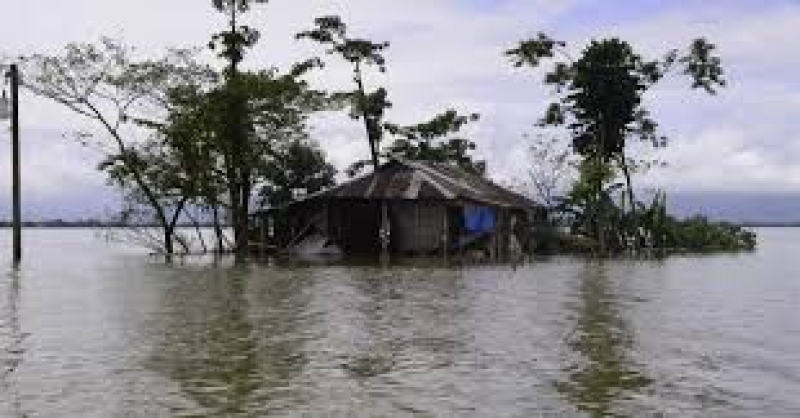- Xi unveils vision for equitable global governance, rejects unilateralism |
- EU Warns Xi-Putin-Kim Alliance a Challenge to World Order |
- Matarbari Project Set to Create 2.5m Jobs, Boost Economy |
- 4,000 ASIs to Be Recruited Ahead of Polls, Says IGP |
- World Heritage Sites Face Rising Water Risks from Climate Change |
Bangladesh Needs 3x Delta Plan Budget for Climate Resilience

Bangladesh needs to triple its annual expenditure to successfully implement the Bangladesh Delta Plan 2100 (BDP 2100), the country’s long-term strategy to safeguard water resources and enhance resilience against climate change and natural disasters.
The government currently spends around 0.8 percent of GDP on delta management projects, according to officials.
Implementing 80 priority projects under the plan will require spending to rise to at least 2.5 percent of GDP in the coming years, said the Climate Financing for Sustainable Development Budget Report 2025-26 of the Finance Ministry.
The Delta Plan 2100 was approved in 2018 aiming to harness the huge potential of Bangladesh as a Delta country through water resource management, ensuring food and water security and tackling disasters.
It sets three national goals and six specific goals for delta regions after identifying six hotspots: coastal areas, Barendra and drought-prone areas, Haor and flash flood-prone zones, the Chittagong Hill Tracts, riverine areas and estuaries and urban areas.
Under its first-phase investment plan up to 2040, the government prioritised 80 projects — 65 infrastructure-related and 15 focused on institutional capacity-building and research, the report says.
Achieving BDP 2100’s targets, including food and water security and disaster preparedness will require an estimated $37 billion by 2030, according to an official document, obtained by UNB.
The document shows that the plan will be implemented in three phases: short-term (up to 2030), medium-term (up to 2050) and long-term (up to 2100).
The Green Climate Fund (GCF) was formed to help developing countries adapt to climate change by limiting or reducing greenhouse gas emissions to combat the damaging effects of climate change.
Although Bangladesh has been somewhat successful in receiving funding from the GCF through multilateral organisations, direct funding through government institutions is rare, said Finance Ministry officials.
The main challenge for public institutions in the region is the inconsistency of the conditions for receiving funds from the GCF with the domestic methods and practices of public financial management.
If the government institutions fail to fulfill these conditions, Bangladesh will be deprived of GCF funds, they said.
In view of extreme threats caused by climate change, it is necessary to reconsider the conditions of receiving funds from the GCF for Bangladesh, taking into consideration the existing financial management system and process.
The GCF currently has eight projects running in Bangladesh.
The total funding amount for the projects is $619.23 million of which $164.86 million is received as grants while the amount of GCF loan is $290 million. The remaining $164.86 million is categorised as Government co-financing.
Officials said Bangladesh expects to secure around $2 billion annually from the Green Climate Fund (GCF) while the rest of the financing will come from development partners, foreign direct investment and private sector contributions.
The BDP 2100 also projects that the private sector could contribute around 0.5% of GDP annually to support delta management initiatives.
Out of the 80 projects, 34 qualify for climate financing, with some, such as the ‘Navigation Protection and Restoration of River Environment around Dhaka City’ under the urban hotspot, offering significant opportunities for both climate and private sector financing.
The government has prioritised climate resilience in coastal, riverine, and urban areas under the Bangladesh Delta Plan 2100 (BDP-2100) but drought-prone regions remain largely overlooked, according to official data.
Out of 80 priority projects identified for the first phase of implementation till 2040, 34 are climate-relevant, focusing on adaptation, mitigation and resilience.
Coastal areas have received the highest attention with 13 out of 23 projects targeting protection against sea-level rise, salinity, and cyclones. River areas and estuaries follow, with five of seven projects addressing erosion and flooding risks.
Urban areas, particularly Dhaka and other major cities, also feature prominently, with five climate-related projects tackling waterlogging, pollution, and river restoration.
Haor and flash flood-prone zones have four of six projects marked as climate-relevant, reflecting their vulnerability to seasonal flooding.
The Barendra and drought-prone regions, however, have no climate-relevant projects, despite being highly exposed to water scarcity and temperature extremes, reports UNB.

